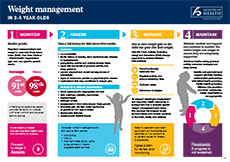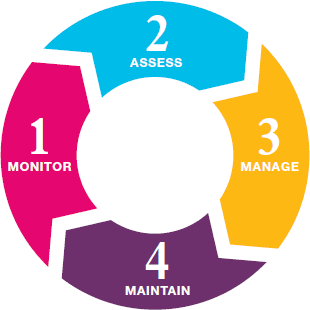
Summary
Addressing overweight and obesity is a government priority. Nearly one third of New Zealand children are either overweight or obese. This is an issue that can have serious long-term effects on the health and wellbeing of children as they grow older.
Evidence shows that an unhealthy diet, excess weight and physical inactivity are three major modifiable risk factors that contribute to early death, illness and disability in New Zealanders. Through helping to identify children who have an unhealthy weight trend or are already overweight or obese, and providing weight management support, we can help to improve their wellbeing both now and into the future.
Weight Management in 2–5 Year Olds is a practical resource to equip health providers with the most up-to-date advice to monitor, assess and manage children who are overweight and obese.
The resource presents a step-by-step diagram which is designed to facilitate clinical decision-making.
The resource is intended for use in conjunction with the Clinical Guidelines for Weight Management in New Zealand Children and Young People.
Weight management steps
There are 4 steps in the resource, which are summarised below. For more detail, download Weight Management in 2–5 Year Olds for Primary Health Care (PDF, 290 KB).

1. Monitor
Monitor growth.
Regularly measure height and weight to calculate Body Mass Index (BMI). Use New Zealand – World Health Organization age- and sex-specific growth charts.
- Overweight: above 91st centile
- Obese: above 98th centile
If a child’s growth is showing an unhealthy trend, even if they are not overweight or obese, provide the family or whānau with brief nutrition and physical activity advice.
If overweight or obese discuss long-term health risks with the family or whānau.
- Proceed to stage 1: Assess.
2. Assess
Take a full history for BMI above 98th centile.
Consider:
- co-morbidities
- family history of obesity, early cardiovascular disease, or dyslipidaemia
- precipitating events and actions already taken
- usual diet and levels of physical activity and sleep patterns
- current physical and social consequences of overweight
- signs of endocrine, genetic or psychological causes
- medications that may contribute to weight gain.
Include in a clinical examination:
- blood pressure with appropriate cuff size
- skin: intertrigo, cellulitis, carbuncles
- hepatomegaly
- enlarged tonsils
- assessment of short stature/poor linear growth
- abnormal gait, flat feet, lower leg bowing or problems with hips or knees
- dysmorphic features
- undescended testicle (boys).
Consider further investigations for BMI above 98th centile:
- lipid profile
- HbA1c
- overnight sleep study, using pulse oximetry if history suggests sleep apnoea.
3. Manage
Aim to slow weight gain so the child can grow into their weight.
Use the Food, Activity (including sleep) and Behaviour (FAB) change approach to address lifestyle interventions.
- Food/nutritionally balanced diet
- Physical activity and reduce sedentary time
- Sufficient sleep
- Behaviour strategies
To support meaningful engagement and improved health outcomes, it is important that a mutually agreed weight management plan takes into account the broader social, environmental and cultural contexts of the child, family and whānau.
Refer to paediatric services if significant co-morbidities are identified or if an endocrine or genetic cause for obesity is suspected. Indicators for endocrine or genetic causes include short stature, developmental delay and dysmorphic features.
Agree a plan for review and monitoring.
4. Maintain
Maintain contact and support and continue to monitor the child’s height and weight to ensure they are adequately supported.
Reinforce healthy eating, physical activity, behaviour strategies and sleep advice.
Identify and promote local support services. Develop collaborative partnerships with Māori health providers, Pacific health providers, Whānau Ora providers and other community-based organisations as appropriate.
Reassess if progress is not sustained.
